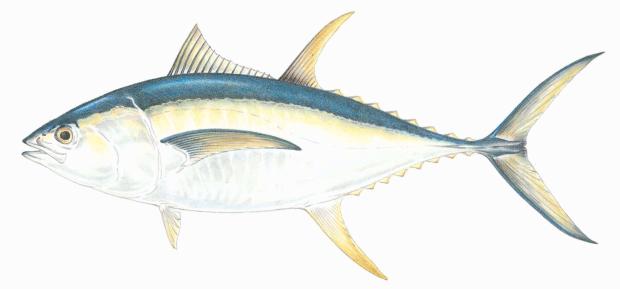Appearance
- Yellowfin tuna are dark blue on the dorsals with yellow fins that gives them their name. They can have a golden yellow on the sides. Yellowfin tuna are shaped like a football, much like other tuna. It is easy to confuse them with bluefin tuna, albacore, and bigeye tuna.
Yellowfin tuna facts
- Species name: Thunnus albacares
- Yellowfin tend to prey on sand lance, squid, mackerel, and butterfish.
- Yellowfin tuna reach sexual maturity at 2 years old. They can produce several million eggs, up to eight million to be exact. They primarily spawn in the Gulf of Guinea and the Gulf of Mexico.
- Water temperature determines the yellowfin tuna's habitat. They live in waters close to the equator that are at least 64 degrees Fahrenheit. During the summer, they are more likely to stay in northern or southern waters.
- Yellowfin tuna resides throughout the Atlantic, Pacific and Indian oceans. Larger harvests occur at fishing grounds in the east Atlantic. In the summer, fishermen spot Yellowfin off the south side of Cape Cod.
- The International Commission for the Conservation of Atlantic Tunas (ICCAT) manages Yellowfin tuna in the Atlantic Ocean. The National Marine Fisheries Service enforces ICCAT regulations. They also manage domestic fisheries. You can contact NMFS for permit requirements and commercial and recreational regulations.
Angling tips
- Yellowfin tuna are challenging to catch with a rod and reel. They can break your tackle if you are not careful. A good spot to fish for yellowfin is south of Martha's Vineyard along the Continental Shelf. You should sail at least 20 miles offshore to attract yellowfin tuna.
- Trolling and chumming are the primary methods used by anglers. Use a pattern of lures that splash and sparkle to trick the fish into thinking it is attacking a group of baitfish. Once you hook a yellowfin, remove the rod from the holder and transfer it to a gimbal belt or back harness. Depending on the size of the fish, it will be quite an exhausting battle. Make sure you are fully prepared for that battle.
- If you plan to release your catch, keep the fish in the water while you remove the hook. Avoid bruising or cutting the tuna during handling. If you plan to boat the tuna, bleed and chill the fish as soon as possible.
- Fresh yellowfin is a popular food, available for sashimi and marinated steaks.
Additional Resources
Contact
Online
DMF Staff Directory
Contact DMF staff
Fax
(508) 990-0449
Address
836 S Rodney French Blvd, New Bedford, MA 02744
